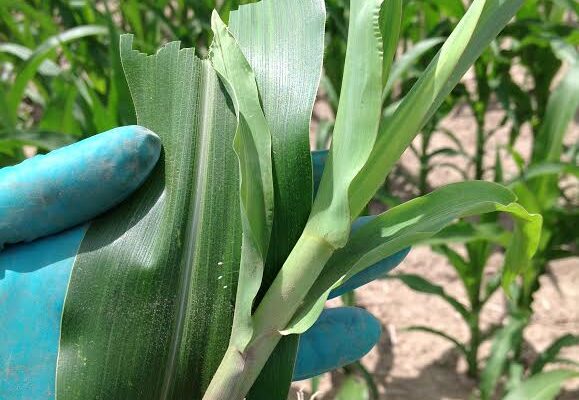Transgenic, genetically modified, or genetically engineered corn, has been modified using molecular techniques to produce proteins identified from another organism. For insect-protected transgenic corn, insecticidal proteins are expressed by the corn plant and provide control of an insect pest that feeds on the plant.
Bt corn has been modified to produce insecticidal proteins that are made by Bacillus thuringiensis (Bt), a naturally occurring bacterium in the soil. There are several strains of Bt, each producing different insecticidal proteins that control specific groups of insect pests.
Non-transgenic Bt products are often used in organic crop protection as a foliar insecticide.

How It Works
Bt proteins are lethal to some life stages of specific moths and beetles. For transgenic Bt corn, the insect pest must ingest plant tissue that expresses the Bt protein (e.g. larvae ingests pollen or silk expressing Bt protein) for it to work. For non-transgenic Bt products, such as foliar sprays, the insect pest feeds on the tissues that the Bt has been applied to (e.g. leaves).
As the insect feeds, their digestive enzymes activate the toxic form of the protein. The insect has an alkaline environment in the gut, which is critical to activate the toxin. The toxin binds to specific receptors on the cells lining of the insects’ gut, causing the cells to rupture. These receptors are specific to the Bt protein structure and must be present for the Bt protein to work. Bacteria from the gut invade the body cavity and the infected insect dies within 24 to 48 hours.
Mammals, including humans, have acidic digestive systems and lack the receptor cells which the Bt protein requires for binding, so Bt protein poses no risk to mammals and is digested like any other protein.
Value of Transgenic Corn
Bt corn has been commercially available in North America for over twenty years. Throughout that time, Bt corn hybrids have proven very effective to protect yield and quality loss from European corn borer and corn rootworm. The use of Bt corn has also resulted in less insecticide use for control of these target pests and protection of natural biological control populations.
In the US, regional suppression of European corn borer and corn earworm populations has been documented since the introduction of Bt corn use (https://www.jstor.org/stable/40931819, https://doi.org/10.1073/PNAS.1720692115). This has resulted in reduced risk of injury and control costs for non-Bt corn growers such as organic producers and producers of other vegetable host crops such peppers, green beans, and sweet corn.
Click images bellow to view full image.
Impact on Non-Target Organisms
Many studies have shown that Bt proteins are highly selective in managing the target pest species. Bt corn does not affect beneficial insects including: honey bees, ladybird beetles, green lacewing larvae, spiders, pirate bugs, damsel bugs, syrphid flies or parasitic wasps. In addition, Bt corn for rootworm control does not affect beneficial soil arthropods including: centipedes, millipedes, carrion beetles, tiger beetles, crickets, ants, spring tails, or earthworms.
However, indirect effects on natural enemies could occur. Predators, parasites and pathogens of the target pests might decline as pest populations decline. Refuge areas may moderate these indirect effects. Potential declines in beneficial species are predicted to be much less than one would expect if a foliar insecticide were to be used.
Research is ongoing to ensure that beneficial and non-target insects are not being affected by transgenic corn technology.
Transgenic Corn and the Monarch Butterfly
The monarch butterfly is one of the most recognized and beautiful butterflies found in North America. The monarch larvae are entirely dependent on the common milkweed for food. Initial U.S. laboratory studies conducted in 1999 found that the mortality rate of monarch larvae increased when fed milkweed leaves that were dusted with Bt pollen. A collaborative research effort across the U.S. Corn Belt and Ontario (University of Guelph) was undertaken to address the potential questions this study posed. These studies expanded on the extensive risk assessment already completed for Bt corn on non-target insects, but also specifically addressed the impact of Bt pollen on the monarch butterfly and other caterpillar species. The main conclusions from the subsequent studies were that Bt corn hybrids grown in Ontario and throughout the Corn Belt of North America pose a negligible threat to monarch butterfly larvae.
Impact of Bt corn pollen on monarch butterfly populations: A risk assessment: https://www.pnas.org/doi/10.1073/pnas.211329998
Full details on the research conducted can be found at: http://www.ars.usda.gov/is/br/btcorn
Click images above to view full image.







